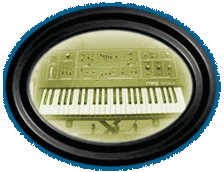Moog Opus 3
The Moog Opus 3 is a typical "Multi Instrument Keyboard" from
1981, with three sections: Strings, Organ and Brass. As opposed to the Korg
Trident, this is not a genuine polysynth but based on "organ technology"
(Top Octave Divide Down). "Glorified String Machine" is another
word for this. However, the Opus 3 has a couple of trumphs on hand...
Let's first take a look aty the structure of the instrument, which can be quite confusing. The basic sound is octave-divided, waveform-converted and distributed to three sections:
Strings (8' and/or 4' sawtooth, with a resonant lp/hp/bp-filter, sadly without filter envelope), Organ (drawbar-like sliders for 16' to 1' square wave, with a simple tone control) and Brass (16', 8' or 4' sawtooth).
The sounds from these three sections can then be sent through a chorus or a fat four pole filter in classic Moog spirit. By means of balance sliders, you can mix Strings/Organ to the Chorus, and Organ/Brass to the filter. That is, the strings cannot be sent through the filter or the brass through the chorus.
There is also an LFO, for modulation of either pitch or filter cutoff frequency (on the four pole filter).
From the Chorus and Filter sections, the sound is sent through an amplifier
with a rudimentary "articulator" (attack/release envelope). You
can select whether the envelope should affect both sections or just the
Chorus signal (typically, having a punchy brass chord followed by swelling
strings with long attack...). The signals from Chorus and Filter (and the
pure signal from the Organ section) have individual volume and pan controls
(yes, the Opus 3 has stereo outputs!).
There is also a pitch bend wheel of the old Moog type (not spring-loaded). Our wheel is extra tricky since it bends by different amounts upwards and downwards.
OK, so what makes the Moog Opus 3 desirable (apart from the Moog logo and the retro-cheezy design)?
First of all it's the nice filter, which has a completely different character than the filters in e.g. SH-101 or Trident. The Moog filter maintains the bottom of the sound even if you push the resonance, which makes it very suitable for fat basses and bumbling childrens-TV-show-of-the-seventies leads. It's also good for resonance flutters, by means of the LFO. Unfortunately there's only one (1) filter (it's a string machine remember - no real polyphonic voice assignment here), and you cannot select Multiple Trig which would have been handy.
The little resonant multimode filter in the String section is also very useful - perfect for those "phasing" Jarre pads.
Finally, as our friend Rotwang put it, it's unexpectedly fun with string machines, since you have so much polyphony at your disposal (49 notes, to be exact)! Huge clangorous chord sheets with swirling chorus, sweeping filters and a lot of cool chord tensions!
SHotQ have used the Opus 3 on all kinds of occasions since buying it in the summer of 2000, but it's best heard in the solo chorus after the growl trumpets in East St Louis Toodle-oo. There, the Moog plays all instruments (bass, chords, solo, effects and even drums, painstakingly multitracked).